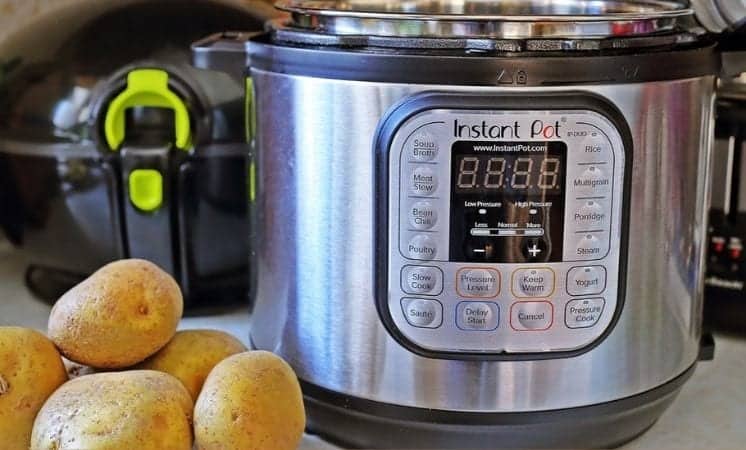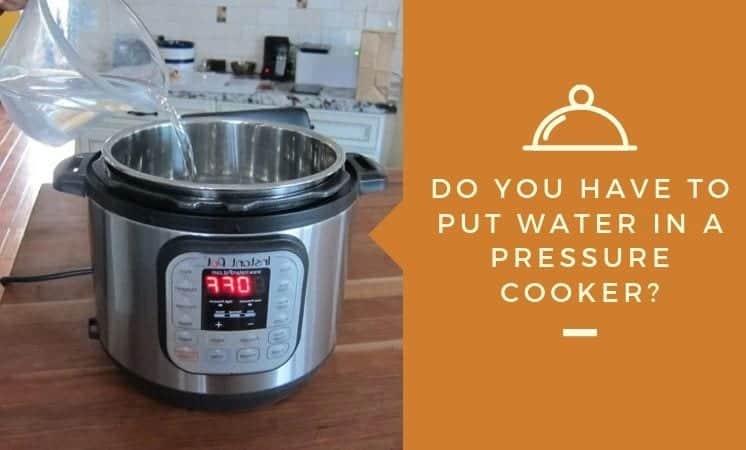Although pressure cookers seem relatively easy to use and are touted often for their time-saving prowess, those who are new to how these kitchen appliances operate, may not understand the role that water plays in its ability to function properly.
For a pressure cooker to cook your food quickly, it must trap steam, which is produced from the boiling liquid, to cause the internal pressure of the cooker to rise quickly. Without the boiling water, you do not have steam, which means no rising pressure in your cooker.
So, do you need to put water in a pressure cooker? Yes. Every single time you want to use your pressure cooker to make a delicious meal, you will need to either add in water or add in another type of liquid like broth or wine prior to use. If you do not add in any liquid, your pressure cooker will not be able to create pressure and will, therefore, not work as intended.
How Much Water Does a Pressure Cooker Need?
The answer to this is dependent on the recipe you are using to cook your meal, the size of the pressure cooker you are using, and what types of food you are cooking with. The best place to find the absolute minimum amount of liquid you will need is in the instruction manual that came with your pressure cooker.
For instance, an Instant Pot pressure cooker requires a minimum amount of 1 1/2 cups or 375ml, while other brands like the Fagor LUX only need 1/2 cup of water or 125 ml. The difference between these two, is that the Fagor LUX brand uses a spring valve instead of the float valves of the Instant Pot.
- For a pressure cooker that has a “jiggle top”, you will want a minimum of one cup of water. This amount of water is enough for twenty minutes of cooking time.
- For a pressure cooker that uses a valve, the minimum amount of liquid required is often 1/2 cup.
If you are still unsure of how much water your pressure cooker needs, choose to fill below the halfway point.
Can You Put Too Much Water in a Pressure Cooker?
While a pressure cooker absolutely must have water in it for the appliance to work, you can put too much water into the vessel. The important thing to remember here is that the pressure cooker is a closed environment, which means that there is significantly less evaporation happening than what would occur with an open pot on your stove.
This means that if you add too much liquid, you can have a dish that lacks flavor, a sauce that is too thin, or a pressure cooker that is overfilled because the food expanded too much.
What you want to do is use anywhere between 1/2 to 1 cup of liquid in your pressure cooker unless you have a specified minimum from the instruction manual or from the recipe itself. When in doubt, always use enough water to bring the pressure cooker to maximum pressure, while staying under the halfway mark.
Can You Overfill a Pressure Cooker with Food & Water?

Even if you have an extremely large pressure cooker, it is not meant to be filled all the way up. In fact, no pressure cooker should ever be filled to the brim with food and water.
Packing in all of your ingredients can cause your food to cook unevenly, prevent the pressure cooker from coming to pressure at all, or cause it to take a very long time to reach maximum pressure. Here are the risks associated with overfilling your pressure cooker.
- Too much pressure on the inside will cause your food to break down and be bland.
- Food can end up blocking the pressure valve. If this happens, you run the risk of increasing pressure levels over and beyond their maximum desired level.
- Overfilling can cause permanent damage to parts of your pressure cooker, including any silicone fittings you have.
- If you overfill and use the manual release method, you are going to get liquid everywhere! Because this liquid is hot, you could get seriously injured with second and third-degree burns.
To find out what the maximum capacity is of your pressure cooker, pull out the instruction manual and find the high and low maximum capacity options.
When you go to cook items like rice and grains, only fill your pressure cooker to half as these foods expand easily. When foods expand, you can get a lot of foam as a byproduct, which can spray out and hurt you if you are not careful with how you remove your pressure cooker’s lid.
Can You Put Oil and Other Liquids in a Pressure Cooker?
When it comes to adding in a flavoring liquid or cooking sauce to your pressure cooker, you can use liquids like wines, broths, vegetable stocks, and beer. Since all of these liquids are relatively thin, they can be used freely up to the maximum liquid volume that your pressure cooker needs to get the job done.
However, if you are planning on adding in thick sauces, these will need to be thinned out by adding at least 1/4 cup of water for every 2 cups of sauce. Why? The sauce will just bur otherwise.
What about dairy products like milk? It is recommended that you do not use cream cheese, yogourt, or milk when pressure cooking because these will separate and curdle with the high heat. It is best to add these into the meal after you are done with the actual cooking portion of the process.
When adding in thickeners like cornstarch or are cooking with a very thick soup or stew, always add them after the food is cooked. Why? Adding these in during the cooking process can negatively impact how the food cooks because less steam gets released from thicker liquids.
Can I Use Oil In My Pressure Cooker?
In terms of using oil in your pressure cooker, it is highly recommended that you do not use it at all. A pressure cooker is not built for frying foods and the use of oil in the vessel can place you in a dangerous situation.
Because a pressure cooker works by increasing its pressure through the liquid, the vapor of the oil will be less because the boiling point of oils is greater than that of water.
This means that you will end up just cooking your oil at high temperatures, either dissolving your sealing ring, overcooking your food, or placing you in a dangerous situation when you go to open up the lid of your pressure cooker.
Please keep in mind that your pressure cooker is not built or designed for frying food. This means that it cannot be a pressure fryer. Why? The temperature needed to generate boiling oil is way too high and is not achievable by most standard pressure cookers.
Am I Stuck With Just Boiling My Food?
Absolutely not! There are plenty of ways you can utilize your pressure cooker, from steaming your food to sauteing them; just make sure that whatever method you use to cook your food, you always clean the pressure cooker out afterward.
To maximize flavor, try browning up vegetables and meats before adding them to your pressure cooker so that you get that Maillard effect taste with a very tender texture.

